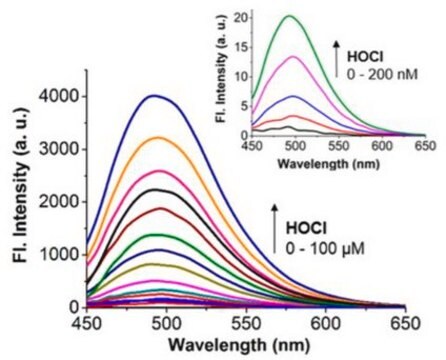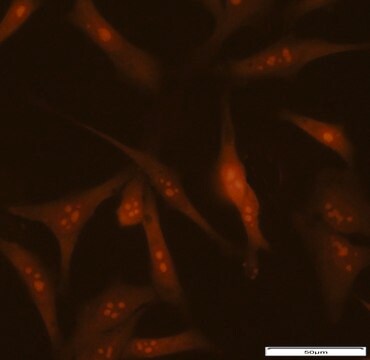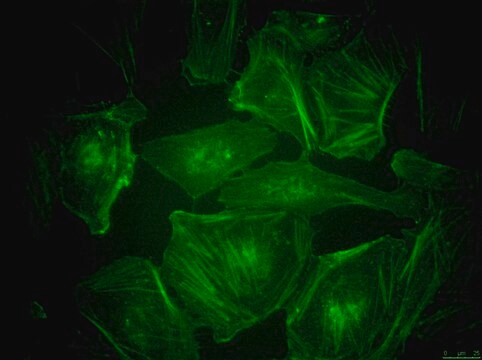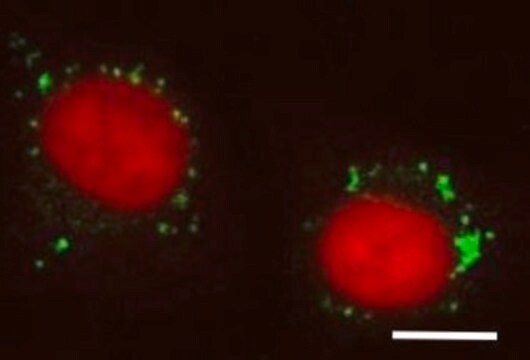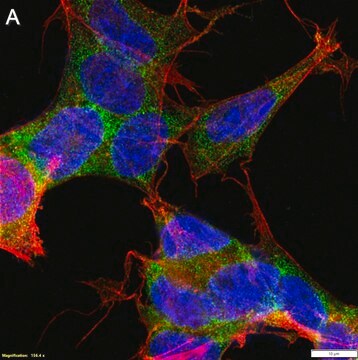SCT235
12110 Sonda aktywności proteasomu TAS2 w żywych komórkach
Human
Synonim(y):
sonda aktywności proteasomu, sonda aktywności proteasomu w żywej komórce
About This Item
Polecane produkty
Nazwa produktu
12110 Sonda aktywności proteasomu TAS2 w żywych komórkach,
pochodzenie biologiczne
human
Poziom jakości
Formularz
lyophilized solid
opakowanie
vial of 500 μg
producent / nazwa handlowa
Millipore
metody
activity assay: suitable
cell culture | stem cell: suitable
flow cytometry: suitable
Warunki transportu
dry ice
temp. przechowywania
−20°C
Opis ogólny
TAS2 jest sondą fluorescencyjną opartą na substracie, przeznaczoną do rozszczepiania i uwalniania przez eukariotyczną podjednostkę 20S cząsteczki rdzeniowej proteasomu w celu monitorowania aktywności proteasomu. TAS2 wykazuje wysoką selektywność i odporność na niespecyficzne rozszczepianie przez proteazy w ludzkiej surowicy. Sonda 12110 TAS2 Proteasome Activity Probe może być skutecznie wykorzystywana w takich zastosowaniach, jak testy na żywych komórkach, cytometria przepływowa lub mikroskopia fluorescencyjna na żywych komórkach.
MW=1407,12 g/mol
Sonda jest rozpuszczalna w DMSO. Robocze stężenie końcowe sondy wynosiło 5-30 uM w odpowiednich pożywkach wzrostowych przez 90 minut.
WŁAŚCIWOŚCI SPECTRALNE
Maks. wzbudzenie λ: 496 nm
Maks. emisja λ: 524 nm
Obrazowanie przeprowadzono za pomocą lasera wzbudzającego 488 nm i okna emisji 515-555 nm.
REFERENCJE
Zerfas BL, Coleman RW, Salazar-Chaparro AF, Macatangay NJ, Trader DJ. 2020. Fluorescencyjne sondy z nienaturalnymi aminokwasami do monitorowania aktywności proteasomu w czasie rzeczywistym. ACS Chemical Biology. 15(9):2588–2596. doi:https://doi.org/10.1021/acschembio.0c00634.
Zastosowanie
Cechy i korzyści
Opis wartości docelowych
Nieprawidłowe funkcjonowanie proteasomu jest związane z wieloma chorobami, w tym z różnymi nowotworami. To sprawia, że proteasom jest bardzo interesującym celem do dalszych badań i potencjalnego rozwoju terapeutycznego.
Postać fizyczna
Przechowywanie i stabilność
Inne uwagi
Informacje prawne
Oświadczenie o zrzeczeniu się odpowiedzialności
Hasło ostrzegawcze
Danger
Zwroty wskazujące rodzaj zagrożenia
Zwroty wskazujące środki ostrożności
Klasyfikacja zagrożeń
Resp. Sens. 1
Kod klasy składowania
11 - Combustible Solids
Klasa zagrożenia wodnego (WGK)
WGK 3
Temperatura zapłonu (°F)
Not applicable
Temperatura zapłonu (°C)
Not applicable
Certyfikaty analizy (CoA)
Poszukaj Certyfikaty analizy (CoA), wpisując numer partii/serii produktów. Numery serii i partii można znaleźć na etykiecie produktu po słowach „seria” lub „partia”.
Masz już ten produkt?
Dokumenty związane z niedawno zakupionymi produktami zostały zamieszczone w Bibliotece dokumentów.
Nasz zespół naukowców ma doświadczenie we wszystkich obszarach badań, w tym w naukach przyrodniczych, materiałoznawstwie, syntezie chemicznej, chromatografii, analityce i wielu innych dziedzinach.
Skontaktuj się z zespołem ds. pomocy technicznej
